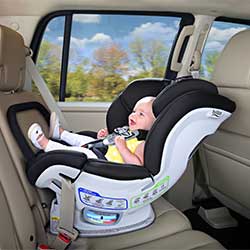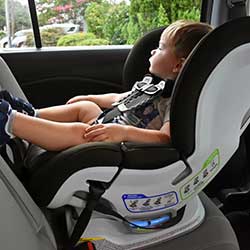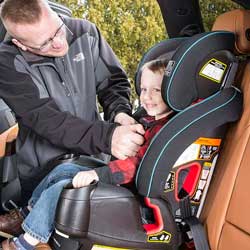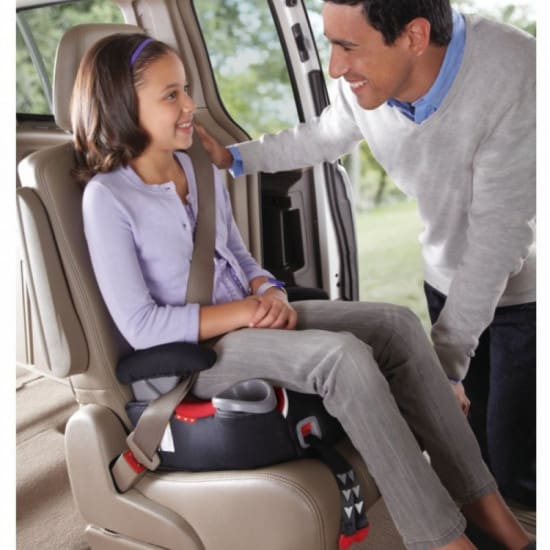
How To Choose A Car Seat
A buyers guide for moms
Before you’re allowed to leave the hospital with a newborn baby, hospitals require new parents to have a car seat to transport the baby home. As such, buying a car seat is essential for any expectant parent.
Whether you’re a new parent, shopping for an expectant loved one, or you’re having another child, you might need to brush up on how to choose the right child seat for you and your baby’s needs.
The car seat you choose is going to see a lot of use during the first several years of your child’s life. Your chosen car seat must be able to handle heavy use and meet all the federal safety standards in a 30mph crash test. Unless you’re digging an old car seat out of the attic, any car seat you can buy in stores has been crash-tested.
When it comes to choosing a baby car seat, you might find yourself tempted to get the most expensive one. It’s a big purchase no matter what, but a higher price tag doesn’t always guarantee a higher safety rating. Not all car seats are created equal.
Some car seats offer more by way of versatility, adaptability to your growing child, conversion, and stroller attachment. Before you select your baby’s car seat, consider your budget, your lifestyle, and how it will fit in your car.
How Do I Pick the Right Car Seat?
Any new parent is bound to feel anxious after the birth of their baby. Car crashes are the leading cause of child deaths, but that shouldn’t make you fear driving with your baby in the vehicle. These guidelines for choosing the right car seat can help you limit your worries and feel confident that your chosen car seat will keep your baby safe.
Types of Car Seats
There are four different types of car seats, and your child will likely need to use different ones as they grow. Some child seat options offer the ability to change the configuration as your child grows. For example, when a newborn baby will need a rear-facing infant car seat. Babies have delicate heads and spinal cords, so make sure that these body parts remain supported and protected at all times—especially in an infant car seat.
Four Types Of Child Car Seats
Rear-facing child seats keep your baby secure with a harness and reduce the stress to your baby’s most fragile parts in the event of a car accident. Most newborn rear-facing car seats are portable and easy to move from the car and carry. Most children will outgrow their rear-facing car seat by their 2nd birthday, but it’s important to note your child’s weight as they grow.
At no point should your child’s weight exceed the car seat’s weight limit, as this can be dangerous and decrease the protection your child has when in the car seat. Some convertible car seats open to allow your child to remain in their rear-facing car seat longer by adjusting to accommodate a higher weight limit.
Similarly, if your child turns two years old before exceeding their car seat’s weight limit, they should continue using it despite their age. Some children will remain in their rear-facing car seats until age 3 or 4.
Height and Weight Considerations
If you opt for a convertible car seat, you will have the option to switch your rear-facing infant car seat to a forward-facing car seat when your child has reached the weight limit. Forward-facing child seats incorporate a 5-point harness to centralize impact on the strongest points of your baby’s body. The 5-point harness limits stress on the head and spinal cord and lower the likelihood of life-threatening injury.
Forward-facing car seats come with a harness to limit forward head movement. The straps of the harness should be snug enough that there is no excess material at your child’s shoulders without digging into their body. Most often, children aged 1 through 7 years or weighing less than 40 pounds use forward-facing car seats.
After your child has reached the weight limit for the forward-facing car seat, then you can start considering a booster seat instead of a baby car seat. Make sure that children continue to use a booster seat until they are 12 years of age or can use a seat belt safely.
To graduate from using a booster seat, seat belts must lie tightly across your child’s legs—not their stomach. The seat belt should also not touch their neck or face.

Things to Consider When Purchasing A Car Seat
When you first start to look at car seats for your baby, it’s easy to get overwhelmed by your options. It’s just as easy to stress about how safe each car seat is, despite what it says on the box.
Buying a child seat that works well for your baby might be one of the first important decisions you’ll make as a parent. While it may be your first time, it’s not ours. There are seven essential factors of how to choose your perfect car seat.
Read Your Car’s User Manual Before You Browse
Your car’s manual will tell you the best way to use a car seat in your vehicle. If you have an older car, you will likely attach the car seat with a seat belt. Newer cars use the Lower Anchors and Tethers for Children (LATCH) system. Make sure you know how to locate your car’s LATCH system before you look for a car seat.
It’s also a good idea to measure your back seat and bring the measuring tape with you when you shop. If you know the depth, width, and length of your back seat, you will be better prepared to select a car seat that correctly fits your car.
Choose a Car Seat that’s Easy to Use
You’re going to be hauling this car seat back and forth from your car to the house a lot. In your child’s first seven years, you’ll get comfortable strapping them into their car seat every time you drive somewhere with them. As such, you should choose something simple to avoid frustration and user error.
The best car seats come with easy-to-understand installation diagrams and detailed instructions. Following these instructions carefully will ensure that the seat is installed correctly for optimal safety. The National Highway Traffic Safety Administrations offers free child safety seat inspections at no cost.
Review the Minimum and Maximum Weight Requirements for Each Car Seat
You want to make sure you’re choosing the right kind of car seat for your child by reviewing the minimum and maximum weight requirements for each car seat.
Newborns and infants are best fitted for rear-facing infant car seats. Children can continue to use rear-facing car seats until age 3 or 4. Convertible car seats’ higher weight allowance gives parents the option to continue using their child’s baby seat well into their toddler years.
Choose a Convertible Car Seat to Get More Bang for Your Buck.
Babies are expensive enough without buying multiple car seats within their first two years. Convertible car seats offer longevity through their versatility. Though convertible car seats do not offer the same portability as baby car seats, convertible car seats are worthwhile investments.
With a convertible car seat, you can keep using the same one through many of your child’s earliest life stages. Convertible car seats allow your child to face toward the rear of the vehicle from infancy until they’re old enough to switch to a front-facing seat. At that point, you can adjust the seat to suit your child’s growth stage.
Consider a Car Seat Stroller
Car seat strollers are one of the most convenient two-for-the-price-of-one baby items available. Think about how often you will be lifting your baby in and out of their car seat and carrying them around with you.
Car seat strollers offer parents the option of carefully transporting sleeping babies from the car to their stroller without ever removing them from their car seats. When you reach your destination or return home, the car seat clicks back into the base in the car.
While car seat stroller options may only suit your child for their first year, the convenience may outweigh the cost of buying a second child seat.
Select a Model with a 5-point Harness.
No matter your budget, it’s crucial to choose a car seat with a 5-point harness. This kind of harness includes shoulder straps, waist straps, and a strap between the legs. It focuses any impact on the strongest points of your baby’s body and limits stress to the spinal cord and other at-risk areas in the event of a crash.
You should also look for models that offer side-impact protection. This protection will usually come in the form of extra foam padding near your baby’s head.
Pick a Car Seat that is Easy to Clean
Children are messy. While there are plenty of fun fabrics and designs to choose from in the car seat world, you’ll want to select something smooth and easy to wipe off.
Just wait until your first unexpected baby barf or when your toddler spills their snack all over their seat. You won’t regret choosing a fabric you don’t have to scrub.
Should You Get a New or Used Car Seat?
Have all your friends or siblings already had their kids? Are they offering you their hand-me-downs? However generous this offer might be, consider how old the car seat they’re giving you is before accepting it.
Old car seats may have outdated straps, latches, and other safety features may be outdated. While you might save big by going with a used car seat, new car seats offer the highest in current safety standards and features.
Child Seat Safety: What You Need to Know
Safety Standards
The safest place for your child’s car seat is the back in the middle seat, but a lot of car manufacturers make it difficult to place car seats there. Narrow, uneven seats without LATCH systems mean car seats often don’t fit or aren’t secure.
It’s best to choose a location in your car that can safely secure the car seat. A car safety inspector—available through the National Highway Traffic Administration—can help you determine the best place to install your child’s car seat. Never install a car seat in your passenger seat.
Read your car seat’s minimum and maximum height and weight requirements to ensure that it is the safest option for your child before you buy or install it. For infants who move or slip in rear-facing car seats, you can place tightly rolled blankets at their sides to keep them secure.
Dress your baby in light layers to keep the harness straps as close to your baby’s body as possible. Often, bulky winter clothes or jackets limit the harness’s ability to properly fit your baby and lessen its efficacy. If you’re worried about your baby getting cold, place a blanket over the harness.
Most parents install or use car seats incorrectly, so review your car seat’s manual to confirm that all buckles and straps are properly secured. Contacting a safety inspector is the most reliable way to confirm that your chosen car seat is compliant with all necessary safety standards. You should also register your car seat after purchase, so you’re aware of all news, recalls, and coupons.
Passenger Seat Placement or Backseat
Under no circumstances should your child’s car seat be installed in the front passenger seat, whether it’s front-facing or rear-facing. The safest place for a child under 12 is in the back seat—far away from passenger-side airbags. Airbags can cause serious injury to your child in the event of an accident.
New vs. Used Car Seats
Whether you’ve been offered hand-me-downs, have had a child before, or you buy secondhand to save money, think carefully about new and used car seats before you buy. In your child’s life, you’re going to have plenty of opportunities to make the most of hand-me-downs, and a car seat may not be one you want to accept.
Before you take someone’s used car seat or pick up one from the secondhand store, consider the following.
Child Safety Seat Expiration Dates
Just like food, all car seats have expiration dates. If a car seat is less than five or six years old, chances are it will still be within its safe date. Before you choose a used car seat, make sure it will not expire before your child grows out of it.
Expiration dates are often found on a manufacturer’s sticker on the back of the seat, so check there be sure it’s still safe for your child.
Does it Have a Manual?
90% of parents use their child’s car seat incorrectly. To minimize the margin for error, follow the exact specifications listed in your car seat’s user manual.
Car seat manuals contain checklists of all the parts included and steps for proper installation. In some cases, you can track down the manual online.
Is it on the Recall List?
The National Highway Traffic Safety Administration keeps an updated list of all car seat recalls. If you’re sure your car seat is not on the recall list, register it with the NHTSA to stay on top of all future recalls.
Car Seat Crash History
If you use a car seat you used previously for your older child or you know the person giving it to you, you’ll likely know the car seat’s accident history. Even one accident or a broken piece can leave the car seat unfit to function at its safest capacity.
Car Seats are Only as Good as Their Plastic
Most car seats are plastic, and plastic degrades over time. In fact, this is why car seats have expiration dates. If a car seat has been sitting in a garage or attic for years, it’s likely to have survived months of heavy use from a previous child, the plastic will have been put through temperature fluctuations, and it may have even started to break down.
Conclusion
When choosing a baby car seat, safety is paramount. By using an updated, secure car seat and following the rules that come with it, you can lower your own anxiety and keep your child safe on the road. Use these tips to understand how to choose a car seat, and you’ll have one less thing to worry about as your baby grows.




